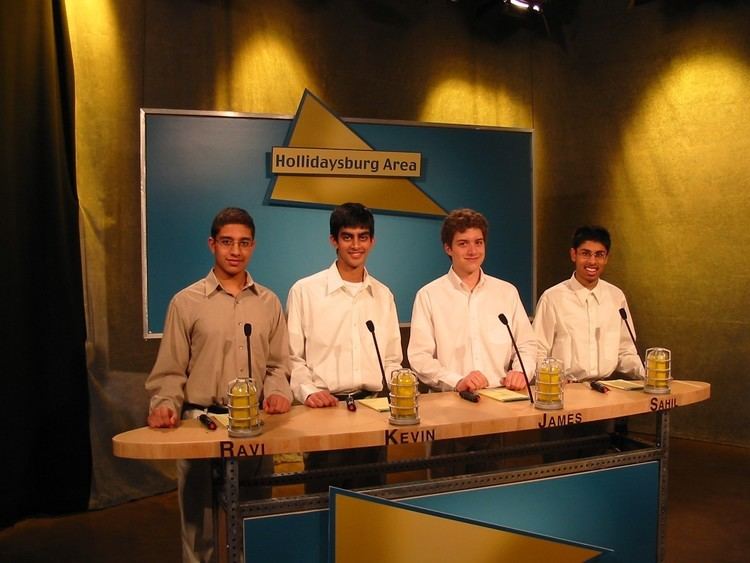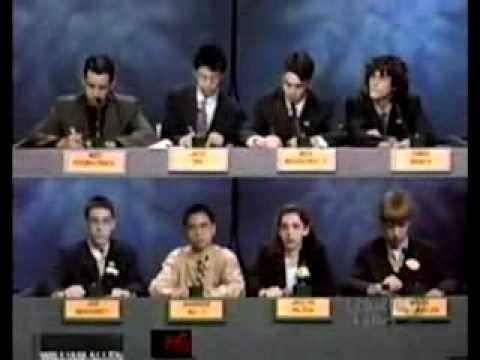First episode date 1980 | ||
 | ||
Pbs39 scholastic scrimmage moravian academy vs wilson hs
Scholastic Scrimmage is a high school quiz bowl game show currently airing on WLVT-TV and is hosted by Dr. Karen Walton, Vice President of Academics at DeSales University. Prior to 2004, the show was hosted by Harry Price. From 2003 to 2009 a version was aired on WPSU-TV (formerly WPSX-TV), for which Harry Price became the host.
Contents
- Pbs39 scholastic scrimmage moravian academy vs wilson hs
- 2015 pbs39 scholastic scrimmage s lehigh vs lehighton
- Game rules
- Records
- Past Scholastic Scrimmage champions
- WPSU TV 3 version
- Changes for season 3
- The tournament
- Changes for season 4
- Changes for Season 5
- Changes for Season 6
- Past Winners
- Trivia
- References

Two teams of four players from Pennsylvania high schools field questions on a diverse range of academic subjects and score points with correct answers. The winners of each game advance in a competitive, season-long tournament.

The WPSU version of Scholastic Scrimmage was canceled in June 2009 due to a smaller budget.
2015 pbs39 scholastic scrimmage s lehigh vs lehighton
Game rules

The game is played in one round of 24 minutes with a half-time separating the round into two segments. The game begins with a toss-up question. Any Player from either team can buzz in to answer the toss-up question, but the players may not confer with their team members. Players must buzz in before time expires to answer the question. The first player to buzz in and give the correct answer earns 10 points and a chance at a related bonus question for their team. If a player answers incorrectly, his/her team loses 5 points from their score (scores can become negative) and his/her team can no longer buzz in for that question. The question is then directed to the opposing team to buzz in (they may not confer). If one of the opposing team members answers the rebounded toss-up correctly his/her team scores 5 points and a chance at a related bonus question. If he or she answers incorrectly on the rebounded toss-up question, his/her team does not lose any points and the contest continues with another toss-up. Similarly, if neither team buzzes in within the time limit, the contest continues with another toss-up.

After answering a toss-up or rebounded toss-up correctly, a team receives one or more bonus questions worth a total of up to 10 points. The team members can confer on the answer, but only the captain can buzz in to answer. Depending upon the number of bonus questions given and answered correctly, the team can receive 0, 5, or 10 bonus points. Play continues in this manner until half-time.

During half-time Dr. Karen Walton, the host, asks the players questions about themselves. These questions vary, but can include their school activities, families, or future plans.

After half-time, play continues exactly as it had in the first segment until a buzzer sounds signaling that time has expired. The team that has the highest score wins the match and advances to the next round of the tournament. The tournament bracket is made up of approximately 32 teams from high schools around the Lehigh Valley (the exact number varies from year to year. At the end of the Scholastic Scrimmage season, the winning school is awarded $4000, with the runner-up receiving $2000. The winning team also receives small trophies, a large trophy for their high school's trophy case, and the bragging rights of being the best team in the Lehigh Valley. The show is currently in its 36th year on WLVT-TV.
Dr. Walton's style of hosting is notable for her not telling players that they have given an incorrect answer. Rather, she will state that the question "goes over to..." the other team or she will state the correct answer.
Records
In the 39-year history of Scholastic Scrimmage, Emmaus High School in Emmaus, Pennsylvania has the best record, with 8 first place and 4 second place finishes. Other notable performances are by Liberty High School with 4 first place and 5 second place finishes, Southern Lehigh High School with 4 first place and 3 second place finishes, Parkland High School with 4 first place and 2 second place finishes, and Moravian Academy with 3 first place and 5 second place finishes. Below is a record of the all the top finishers.
Past Scholastic Scrimmage champions
An "All-Star" version of the Scholastic Scrimmage 2008-2009 Season was taped May 19, 2009 and aired June 6, 2009. In this show, two teams were each composed of four players from different high schools. (Eight total schools were represented.) The final score was team Einstein (score-110) vs team Newton (score-85).
reference page: http://www.wlvt.org/EDUCATION/SCHOLASTICSCRIMMGE/ss-2009.htm
WPSU-TV 3 version
The game was played in three rounds of approximately 6 minutes each. Each round began with host Harry Price asking a toss-up question. Players buzz in to answer the toss-up question; the first player to buzz in with a correct answer earned 10 points and a chance at a related bonus question (a "follow-up") for their team. An incorrect answer incurred no penalty, but the opposing team got to try to buzz in and score 5 points on a rebounded toss-up.
Regardless of whether the team scored 5 or 10 on the toss-up, they got to confer and try to answer a follow-up question for another 10 points (in season 1, sometimes a two-parter at 5 points per part, but from season 2 onward, always a single 10-point question). The designated captain had to buzz in before conferring time expires to indicate readiness to answer.
A distinctive "chime" sound signaled the end of each of the first two rounds. At that time, Harry Price chatted with each team (from season 3 on, always the team that just played a Fast Track, see below), and at the downward buzzer that ended the final round, the team in the lead won, and advanced in a season-long tournament (seasons 1 through 3; see the section on the Tournament below for season 4 changes). The winning school received one scholarship which they were permitted give to any student to attend any Penn State campus. In season 3, each member of the championship team received a ring engraved with the show's logo, much like an NFL Super Bowl ring; this also occurred at the end of seasons 4 and 5, and all players received a yearbook of all the participating teams.
The final episode was an hour in length. In the first season, there were three extended-length rounds. In seasons 2 and 3, there were four rounds in the game (and two Fast Track rounds to each team starting in the third season, the second pair being back-to-back after the third round; see below). The chime signaled completion of the first three rounds, and, as always, the downward buzzer ended the game. Seasons 4 and 5 saw the teams play 5 rounds, with a Fast Track after each of the first four rounds (see below).
Changes for season 3
The tournament
In seasons 1 through 3, the tournament used the following format: An opening round was played with all the teams. Then, additional qualifying matches were played with the lowest-scoring winners if there were more than 64 teams, or with the highest-scoring non-winners if there were less. Either way, this would result in a 32-team elimination tournament that continued until there were two teams left, who would play off in the hour-long special.
In season 4, because of the expansion to 82 teams, the top 8 highest-scoring teams from the opening round, win or lose, played in the round of 16. The next 16 highest-scoring teams, again, win or lose, played a wild-card round of 8 matches for the remaining 8 spots in the round of 16.
In season 5, there was no longer a wild-card round. Only the 16 highest-scoring teams from the qualifying round qualified for the round of 16.
In season 6, the 90-team field was divided into three separate brackets of 30 schools each based on school size. Each bracket was a single-elimination tournament in and of itself, except that each division's highest-scoring non-winning team from the first round was given a spot in the second round.
Changes for season 4
Changes for Season 5
Changes for Season 6
Past Winners
The past winners are as follows:
Note that most winning scores are between 150 and 250. The higher scores in the Championship game in seasons 1-5 are due to its expanded length.
